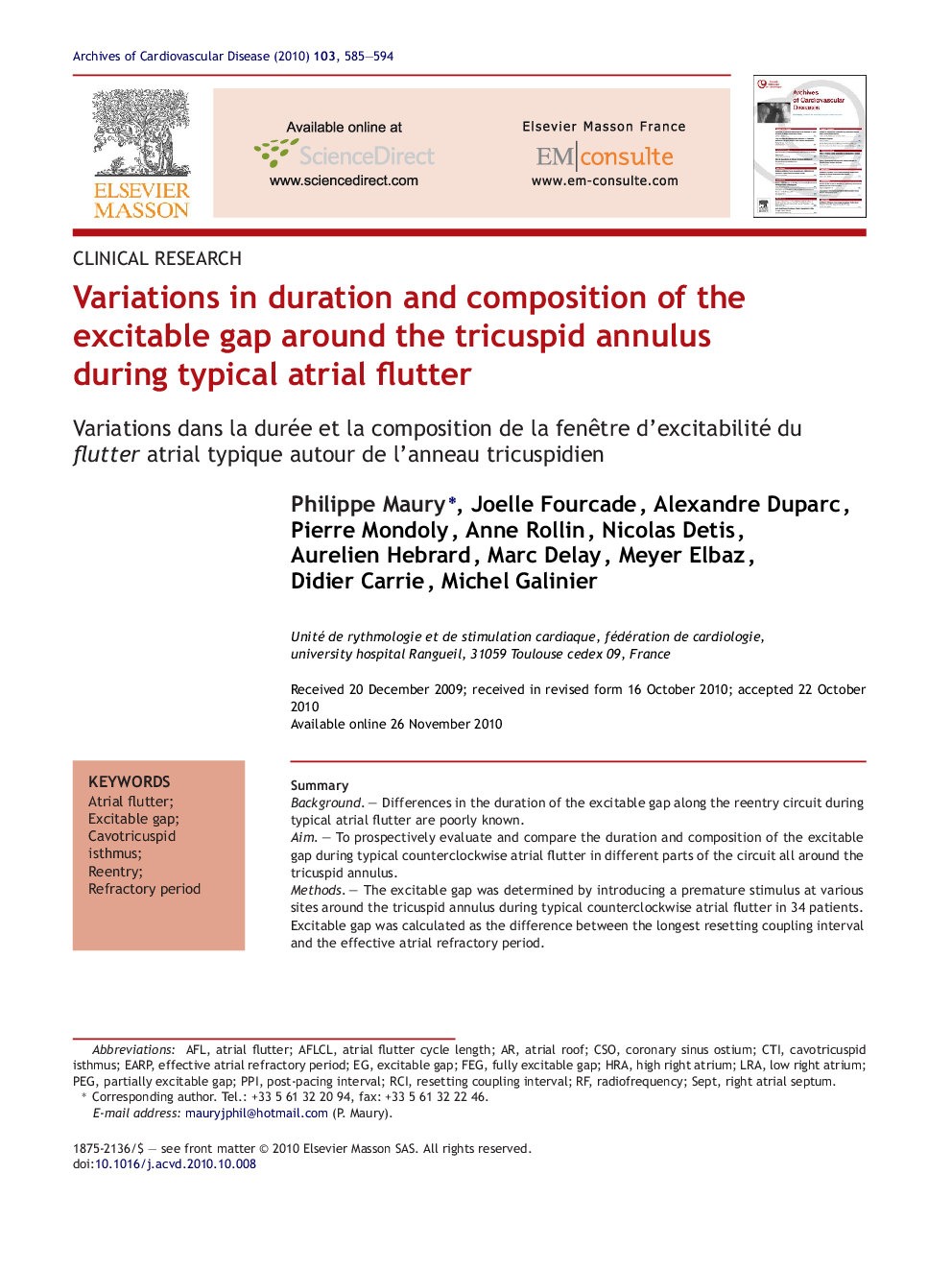| کد مقاله | کد نشریه | سال انتشار | مقاله انگلیسی | نسخه تمام متن |
|---|---|---|---|---|
| 2889268 | 1574389 | 2010 | 10 صفحه PDF | دانلود رایگان |

SummaryBackgroundDifferences in the duration of the excitable gap along the reentry circuit during typical atrial flutter are poorly known.AimTo prospectively evaluate and compare the duration and composition of the excitable gap during typical counterclockwise atrial flutter in different parts of the circuit all around the tricuspid annulus.MethodsThe excitable gap was determined by introducing a premature stimulus at various sites around the tricuspid annulus during typical counterclockwise atrial flutter in 34 patients. Excitable gap was calculated as the difference between the longest resetting coupling interval and the effective atrial refractory period.ResultsThe duration of the excitable gap, the effective atrial refractory period and the resetting coupling interval differed significantly along the tricuspid annulus. Duration of excitable gap was significantly longer at the low lateral right atrium (79 ± 22 ms) than at the cavotricuspid isthmus (66 ± 23 ms; P = 0.002). The effective atrial refractory period was significantly longer at the cavotricuspid isthmus (160 ± 26 ms) than at the high lateral right atrium (149 ± 29 ms; P = 0.004). Other locations, such as coronary sinus ostium, right atrial septum and atrial roof displayed intermediate values.ConclusionThe duration of the excitable gap differed significantly along the tricuspid annulus, with a larger excitable gap at the lateral right atrium and a shorter excitable gap at the cavotricuspid isthmus, because of longer refractory periods at the isthmus.
RésuméContexteLes différences dans la durée et la composition de la fenêtre d’excitabilité (EG) le long du circuit de réentrée dans le flutter typique (AFL) sont mal connues chez l’homme.ObjectifsÉvaluer et comparer la durée et composition de la fenêtre d’excitabilité du flutter typique antihoraire à divers sites du circuit de réentrée autour de l’anneau tricuspidien.MéthodesL’EG a été déterminé en introduisant un stimulus prématuré à divers sites autour de l’anneau tricuspidien en cours de AFL antihoraire chez 34 patients. EG a été calculé par la différence entre le couplage le plus long recyclant le flutter (RCI) et la période réfractaire atriale (EARP).RésultatsLes durées de l’EG, EARP et RCI diffèrent significativement le long de l’anneau tricuspidien. L’EG était plus long dans l’oreillette droite latérale basse (79 ± 22 ms) que sur l’isthme cavo-tricuspidien (CTI) (66 ± 23 ms ; p = 0,002). Les EARP étaient plus longues sur le CTI (160 ± 26 ms) que dans l’oreillette droite latérale haute (149 ± 29 ms ; p = 0,004). Les autres localisations comme l’ostium du sinus coronaire, le septum inter-atrial droit ou le toit de l’oreillette droite montraient des valeurs intermédiaires.ConclusionLa durée de l’EG diffère significativement le long de l’anneau tricuspidien, avec un EG plus large dans l’oreillette droite latérale et un EG plus court sur le CTI du fait de périodes réfractaires plus longues sur l’isthme.
Journal: Archives of Cardiovascular Diseases - Volume 103, Issues 11–12, November–December 2010, Pages 585–594